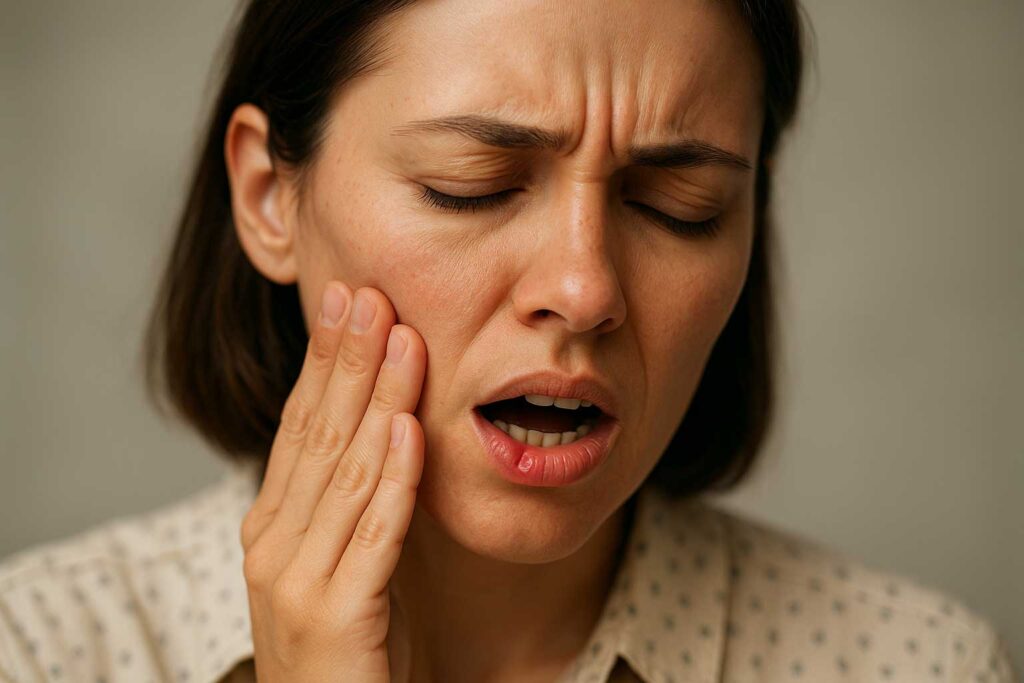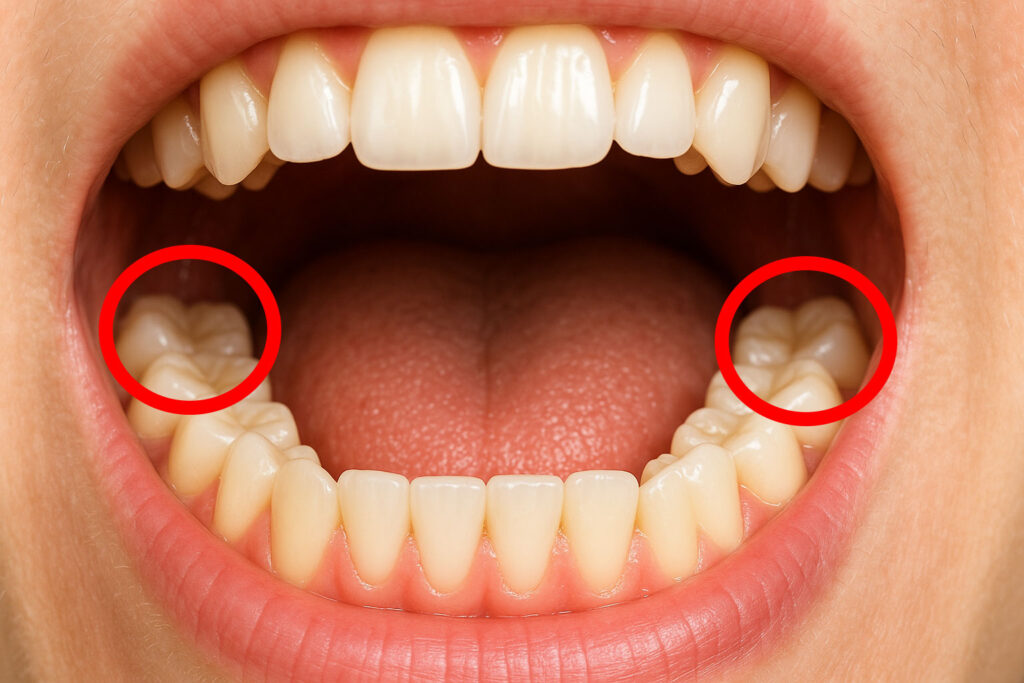In this article I explain in a practical way what canker sores are, why they appear and how to relieve the pain and accelerate their healing with simple solutions. You will learn about the most common causes, when it is necessary to visit the dentist, and you will find a “cause ↔ solution” comparison table, as well as an explanatory video and answers to the most common questions.

What are canker sores?
Canker sores, also known as aphthous stomatitis, are small ulcers or superficial sores that appear on the inner mucosa of the lips, cheeks, soft palate or base of the tongue. They usually measure between 2 and 10 mm in diameter, have a whitish or yellowish center surrounded by a red inflamed border, and are very painful when rubbed with food, drinks or during brushing. Unlike viral ulcers, canker sores are not contagious and usually resolve by themselves in 7 to 14 days, although they may recur with some frequency.
Incidence and risk factors
Canker sores are a very common condition, occurring in a wide range of the population:
>>> Do you live in Mallorca? Book your free first appointment <<<
- General prevalence: Between 20 % and 30 % of people will present with aphthous ulcers at least once in their lifetime. Although most cases are sporadic and resolve without complications, in 10-15% of those affected the ulcers become recurrent, reappearing every few weeks or months and becoming a chronic nuisance.
- Most affected ages: Aphthous stomatitis recurs most frequently during adolescence and young adulthood (between 15 and 40 years of age), often coinciding with periods of increased stress, hormonal changes or active lifestyles. However, no age group is exempt: they can appear in early childhood, middle age or even in older people, where aphthous ulcers are sometimes associated with other pathologies or pharmacological treatments.
Main risk factors
- Physical and emotional stress
- Outbreaks of canker sores often coincide with times of stress: exams, tight work deadlines, intercurrent illnesses or sudden changes in routine.
- Chronic stress can weaken the local defenses of the oral mucosa and alter the immune response, favoring both the onset and duration of ulcers.
- Local microtrauma
- Accidental bites, too vigorous brushing or constant friction from brackets, dentures or sharp dental edges generate small wounds that trigger the formation of canker sores.
- Continued friction can impede healing and prolong the tingling sensation or pain.
- Nutritional deficiencies
- Low levels of iron, folic acid and B vitamins (especially B12 and B6) are strongly related to the frequency and severity of canker sores.
- A diet poor in fruits, green leafy vegetables and legumes increases the risk; correction of these deficits usually results in a significant reduction in outbreaks.
- Food sensitivity
- Very acidic or spicy foods (citrus fruits, pineapple, nuts with hard shells, intense spices) can irritate the mucosa and precipitate the appearance of thrush.
- Intolerances or allergic reactions to certain components (e.g. sulfites in wines or preservatives in sausages) may also manifest themselves with painful ulcers in the mouth.
- Immunological alterations
- Autoimmune diseases (lupus, Crohn’s disease, Behçet’s disease) and states of immunosuppression – due to oncological treatments, immunosuppressants or HIV infection – predispose to more numerous and longer-lasting outbreaks.
- In these cases, thrush may be one of the first symptoms of a broader immune system imbalance.
- Genetic predisposition
- There is a clear familial tendency: if one or both parents suffered recurrent aphthous stomatitis, the probability of their children suffering from it increases.
- This hereditary component suggests differences in the way the oral mucosa reacts to internal and external stimuli.
Knowledge of these risk factors is essential to differentiate an isolated aphthous ulcer – which only requires local care – from an episode that may require medical evaluation or changes in lifestyle and diet. Correct recognition and control of the triggers can reduce the frequency, intensity and duration of canker sores, improving the comfort and quality of life of the sufferer.
Main causes of canker sores
- Microtrauma to the mucosa
Small everyday bumps or grazes are often the most frequent initiator of an aphthous ulcer. Brushing too vigorously – especially with a stiff-bristled brush – can damage the surface layer of the mucosa and trigger a sore. Similarly, unintentionally biting the inside of the lip or cheek when eating or talking, as well as the continuous rubbing of braces, ill-fitting dentures or sharp edges of fillings, creates a point of inflammation where epithelial cells are exposed to bacteria and acids from saliva, delaying healing. - Nutritional deficiencies
Vitamins and minerals play an essential role in tissue repair. An iron deficiency interferes with the production of healthy red blood cells and cell regeneration of the oral mucosa, while a lack of folic acid and B complex vitamins (B12, B6) reduces the synthesis of DNA and proteins necessary for ulcers to close. Patients with diets poor in green leafy vegetables, lean meats or fatty fish often present recurrent aphthous ulcers until the deficiency is corrected. - Alterations of the immune system
In conditions of autoimmunity or immunosuppression, the defense system itself exaggeratedly attacks healthy tissues, including the oral mucosa. Diseases such as celiac disease or inflammatory bowel diseases activate inflammatory mediators that can manifest as aphthous ulcers. Likewise, oncological treatments or immunosuppressive drugs reduce the cellular response capacity and cause larger and longer lasting lesions. - Physical or emotional stress
Stress triggers the release of cortisol and other hormones that alter the balance of the immune system and reduce blood flow to the oral mucosa. For this reason, in times of exams, work conflicts or major changes in routine (relocation, childbirth, change of job), canker sores often appear just when we most “need” to avoid them. In addition, insomnia and prolonged fatigue worsen the natural repair mechanisms of the skin and mucous membranes. - Dietary and lifestyle factors
Highly acidic (citrus fruits, pineapple), spicy (chili, paprika) or salty foods directly irritate the mucosa and favor ulcer formation.
Tobacco and alcohol act as local toxicants: they decrease saliva production, dry the mucosa and alter its protective barrier. Some food additives, colorants or preservatives can also trigger hypersensitivity reactions that, in susceptible individuals, result in repeated aphthous ulcers. Reviewing the diet and moderating these triggers is essential to reduce outbreaks.
| Cause | Practical solution |
|---|---|
| Microtrauma to the mucosa |
|
| Nutritional deficiencies |
|
| Immune system disorders |
|
| Physical or emotional stress |
|
| Dietary and lifestyle factors |
|

Diagnosis and when to visit your dentist
How to recognize a canker sore
A typical canker sore appears as a small round or oval ulcer, 2 to 10 mm in diameter, with a whitish or yellowish center and a red, inflamed outline. It usually hurts on contact with acidic or spicy foods or when brushing, and it is common to feel a constant dry discomfort or irritation in the affected area. Unlike herpetic ulcers, aphthous ulcers are not accompanied by fever or grouped blisters, and are not contagious.
Initial self-diagnosis
- Visual inspection: With good light and a mirror, locate the lesion and assess its shape and color.
- Topical gel relief test: Apply an over-the-counter gel or ointment (with local anesthetic or film-forming). If the pain improves markedly, it supports the diagnosis of common canker sore.
- Recording of episodes: Note date of onset, duration and triggering factors (food, stress, microtrauma). This helps identify patterns and facilitates professional consultation.
When to consult a dentist or physician
You should seek professional evaluation if any of these conditions are met:
- Prolonged duration: The canker sore persists for more than 14 days without signs of healing.
- Excessive size or number: Lesions larger than 10 mm in diameter or more than three simultaneous aphthous ulcers.
- Severe pain: Discomfort so intense that it makes it difficult to speak, chew or swallow.
- Frequent recurrence: More than 6-8 flares per year, suggesting an underlying problem.
- Systemic symptoms: fever, swelling of cervical nodes, unexplained fatigue or appearance of similar lesions on skin or other mucous membranes.
- History of chronic diseases: celiac disease, inflammatory bowel disease, HIV/AIDS, or immunosuppressive/chemotherapy treatments that may complicate healing.
Recommended complementary tests
- Complete blood test: To rule out deficiencies of iron, folic acid or vitamins B12 and B6.
- Serologies and immunological markers: If there is suspicion of autoimmune or related systemic diseases.
- Biopsy or culture of the lesion: In cases of atypical, very persistent aphthous ulcers or when there is a risk of another pathology (e.g. Behçet’s disease or neoplasms).
An accurate diagnosis not only confirms that the lesion is a common oral thrush, but also helps to rule out more serious disorders. Early consultation ensures proper treatment, reduces pain and prevents unnecessary complications or recurrences.
Rapid relief of canker sores
Rinse the mouth with warm saline water (1 teaspoon of salt in a glass of water), apply a topical gel with anesthetic (lidocaine) on the ulcer and avoid acidic or very spicy foods. With these cares you will notice pain reduction in a few hours and healing in 3-5 days.
Rapid resolution and initial care
To accelerate the healing of the canker sore and relieve pain from day one, follow these steps:- Warm saline rinses
- Prepare a glass of warm water with half a teaspoon of fine sea salt.
- Gargle gently and leave the liquid in the mouth for 30 seconds before spitting it out.
- Repeat 3-4 times a day, especially after meals. Salantisepticity reduces the bacterial load and helps to reduce inflammation.
- Application of gel or ointment for topical use
- Use specific products for canker sores containing hyaluronic acid, aloé vera or lidocaine (local anesthetic).
- With a clean cotton swab or finger, cover the lesion with a thin layer of gel 2-3 times a day.
- Avoid eating or drinking for at least 30 minutes after application to allow a protective barrier to form.
- Mechanical protection of the ulcer
- If the canker sore is in the area where it rubs against brackets or prostheses, apply dental wax to cover any sharp points.
- For canker sores on the lip or cheek, protect the area with specific oral dressings in patches, which release gel for hours.
- Pain and inflammation control
- Take an over-the-counter anti-inflammatory drug (ibuprofen 400 mg) after meals, if there is no medical contraindication.
- Alternate with an analgesic (paracetamol 500-650 mg) if the pain is very intense, always following the instructions on the package insert.
- Hydration and gentle feeding
- Drink plenty of water and avoid very hot or cold drinks.
- Consume soft, non-irritating foods: purees, yogurt, boiled rice, compotes.
- Avoid citrus fruits, spicy foods, hard nuts and salty foods until the thrush improves.
- Mouth rest
- Reduce the intensity of brushing: use an ultra-soft brush and toothpaste without sodium lauryl sulfate, which can aggravate irritation.
- Avoid flossing directly on the canker sore; use gentle movements so as not to dislodge the forming crust.
Treatments and therapeutic approaches
For canker sores that do not respond to initial measures or that are very painful and recurrent, the dentist or physician may prescribe:
- Topical corticosteroids
- Clobetasol cream or gel: applied directly on the ulcer limits local inflammation and accelerates healing. It is usually used in short cycles (5-7 days) to minimize side effects.
- Betamethasone dipropionate rinse: steroid solution gargle that covers the entire oral mucosa, useful when there are multiple aphthous ulcers.
- Antiseptics and antimicrobials
- Chlorhexidine 0.12-0.2 % rinse: reduces the bacterial load of saliva and prevents secondary infections. It is recommended to use after brushing, 2 times a day.
- Triclosan or cetylpyridinium chloride mouthwashes: alternatives for patients sensitive to chlorhexidine.
- Analgesics and barrier protectors
- Sucralfate in suspension: forms a viscous film that covers the canker sore and protects the area for several hours, reducing pain when eating or talking.
- Benzocaine or lidocaine tablets: to be sucked or applied on the lesion, they relieve pain immediately (short-lasting effect).
- Specific nutritional supplementation
- Iron, folic acid and B complex supplementation: after confirming the deficiency in analytical tests, the correction of the deficiency clearly reduces the frequency of outbreaks.
- Oral probiotics: strains such as Lactobacillus reuteri can help balance the oral microbiota and promote healing.
- Adjuvant therapies
- Low level laser (LLLT): some studies show that the application of diode lasers to the lesion shortens healing time and relieves pain without the need for drugs.
- Photodynamic therapy: use of a photosensitizer and specific light to reduce microorganism load and modulate inflammation.
- Treatment of the underlying cause
- Systemic diseases: coordination with the physician to control conditions such as celiac disease, inflammatory bowel disease or immune imbalances.
- Review of drugs: assess substitution or adjustment of immunosuppressive treatments or treatments that may predispose to ulcers (e.g., HIV/AIDS drugs or chemotherapy).
- Patient follow-up and education
- Outbreak diary: record date of onset, duration and associated factors (stress, diet, trauma) to adjust the therapeutic plan.
- Personalized oral hygiene instructions: recommend products without sodium lauryl sulfate, rinses and ultra-soft brushes.
- Periodic visits plan: control the evolution of the treatment, reinforce preventive measures and rule out other pathologies if the lesions persist.
This combined approach – topical treatments, advanced therapies and correction of risk factors – not only relieves pain and accelerates healing, but also reduces the frequency and severity of new outbreaks, substantially improving the patient’s quality of life.
Key recommendations
- Anticipate outbreaks by correcting diet and habits.
- Act quickly at the first symptom with rinses and gels.
- Consult if… the lesion lasts > 14 days, recurs frequently, or is accompanied by other systemic symptoms.
- Maintain consistency in hygiene routines and professional control to minimize pain and accelerate recovery.
With this comprehensive approach, most patients experience a marked reduction in pain, faster healing of ulcers and less recurrence of canker sores in the future.

When to go to the professional
Warning signs
If bad breath persists despite proper oral hygiene, seek professional evaluation. A red flag should be raised when unpleasant breath and taste are accompanied by swollen or bleeding gums, pain when chewing or an excessively dry mouth sensation. These symptoms may indicate advanced periodontal processes or infections that require specific treatment.
Frequency of check-ups
Even if there is no obvious discomfort, it is recommended to visit the dentist at least once a year for a general check-up and professional cleaning; in patients with chronic halitosis or a history of gum disease, it is advisable to schedule biannual visits. These periodic visits allow early detection and correction of any bacterial focus or defects in dental restorations.
Coordination with other specialists
When the oral evaluation rules out clear oral causes, the dentist may refer the patient to an otolaryngologist in case of suspected respiratory problems (sinusitis, tonsils) or to a gastroenterologist if there are signs of gastroesophageal reflux. In the presence of systemic diseases such as diabetes or medication-induced xerostomia, collaboration with the family physician or the corresponding specialist is essential to address the extraoral origin of bad breath.
Resources and recommended reading
- Official guides and reference articles
- “Aphthous Ulcers (Canker Sores) ” – Mayo Clinic: clinical information, warning signs and standard treatment.
- “Recurrent aphthous stomatitis: clinical symptoms and management” – Journal of Oral Pathology & Medicine: review of advanced therapeutic approaches.
FAQ (frequently asked questions)
Why do I get canker sores?
Canker sores are usually caused by microtrauma to the mucosa, nutritional deficiencies (iron, B12, folate), stress, hormonal changes or autoimmune diseases.
Are canker sores contagious?
No. Canker sores are not transmitted from person to person because they are not of viral or bacterial contagious origin, but due to internal or mechanical causes.
How long does it take for a canker sore to heal?
With proper care, it usually heals in 7-10 days. If it persists for more than 2 weeks, it is advisable to consult a dentist.
Can I use chlorhexidine rinses?
Yes, a 0.12% rinse can reduce the bacterial load and prevent secondary infections. Use it after brushing, once or twice a day.
Does my diet influence the appearance of canker sores?
Yes, very acidic, spicy or salty foods irritate the mucosa. Moderate citrus fruits, chili peppers and strong sauces to reduce episodes.
Do vitamin supplements help?
If there is a confirmed deficiency of iron, vitamins B12 or folic acid, supplementation improves healing and reduces relapses.
Can stress cause canker sores?
Effectively. Physical and emotional stress alters the immune system and decreases the mucosal repair capacity, favoring ulcers.
Should I change my toothbrush?
Yes, use a very soft bristle brush and lauryl sulfate-free paste to avoid microtrauma and dryness.
When should I visit the dentist?
If a canker sore lasts more than two weeks, is extremely painful, occurs very frequently (more than 6-8 per year), or is associated with fever and swollen glands.
 Whatsapp
Whatsapp




